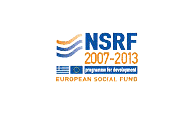- Home
- Argo in brief
- Greek Argo Project
- Outreach
- Media Center
- Greek Argo in schools
- School visits
- Educational Material
- Useful links
- Documents
- Contact us
Frequently Asked Questions
When a float reaches the surface, the data are transmitted and the float's position is determined. The data are monitored by the Argo Information Centre in Toulouse and then received by national data centers (DACs). At the DACs, they are subjected to initial scrutiny where erroneous data are flagged and/or corrected and the data are passed to Argo's two Global Data Assembly Centers (GDACS) in Brest, France and Monterey, California. The GDACs are the first stage at which the freely available data can be obtained via the internet. The GDACs synchronize their data holdings to ensure consistent data is available on both sites. The data reach operational ocean and climate forecast/analysis centers via the Global Telecommunications System (GTS).
The target is for these "real-time" data to be available within approximately 24 hours of their transmission from the float.
In addition to the real-time data stream, Argo has the potential, after careful data assessment, to provide salinity/temperature/pressure profiles that approach ship-based data accuracy.
In general there is no possibility of carrying out calibration checks on a float's sensors after it has left the laboratory or has been launched by a research ship that might make a nearby CTD cast. One means of adjusting salinities is to look at deviations of the float data from a stable, deep temperature/salinity climatology [Owens et al., 2009, Bohme et al., 2005, Wong et al., 2003], or to compare profiles from floats that coincide in space and time. The OW method (Owens et al., 2009) has been adopted by Argo as its standard means of delayed mode data quality control. The delayed-mode quality control is the responsibility of researchers in each country in collaboration with the appropriate national data center. It has been recommended that delayed mode data inspection is carried out on a 1 year long record so that sudden jumps in calibration may be distinguished from long term drift or water mass property changes. This imposes a minimum 6 month delay on the availability of delayed mode data.
This system was adopted in 2004 and is now being applied to Argo data. These delayed-mode data are currently available from the GDACs. To learn more about the data management of Argo and how to use the Argo data effectively, visit the Coriolis Site.
An additional phase of Argo data management occurs at a regional level at the Argo Regional Centers (ARCs). This enables the accumulation of consistent regional data sets and the production of Argo based products. To learn more about the Argo Regional Centers, go to ARC page.
More information and a brief user guide to the Argo data is given here: http://www.argo.ucsd.edu/Argo_date_guide.html .
Complete documentation of the Argo data system is contained in the “Argo Data Management Handbook” and “Argo Real-time Quality Control Tests Procedures”, both of which are available at http://www.argodatamgt.org/Documentation .
Argo data are used by weather and climate centers to help understand the way the oceans affect climate. These centers are working to improve weather forecasts and to understand other climate features like monsoons and global warming. Argo has now become the main source of subsurface temperature and salinity from the deep oceans. Data after passing some quality control tests are freely and easily accessible for the scientific community and other users.
The floats have a pressure case made of aluminium that is about 1.3m long and about 20cm diameter. They weigh about 40kg. On the top is an antenna to communicate with the satellites that fix the float's position and receive the data. Also on the top are the temperature and salinity sensors. At the bottom of the float in a protective cover is a bladder that is connected to the inside of the float. The floats are designed so that with the bladder empty they have the same density as seawater at the depth at which they drift. They are also designed to be less compressible than sea water. This keeps them stable at depth.
The floats are put in the ocean from ships or aircraft and sink to depth. After 10 days oil is pumped into the bladder and drives the float to the surface. At the surface it is positioned by satellites and downloads its temperature/salinity profile. The bladder then deflates and the float sinks back to depth to repeat the cycle.
The floats make no noise in the ocean and they do not contain materials that are not found elsewhere in the oceans. We take care to ensure that they are handled properly if they are found by fishermen or beachcombers. They are small and light enough to pose no significant hazard to ships and boats.
As the float ascends a series of typically about 200 pressure, temperature, salinity measurements are made and stored on board the float. These are transmitted to satellites when the float reaches the surface.
For most floats in the Argo array the data are transmitted from the ocean surface via the Système Argos location and data transmission system. The data transmission rates are such that to guarantee error free data reception and location in all weather conditions the float must spend between 6 and 12 hrs at the surface. Positions are accurate to ~100m depending on the number of satellites within range and the geometry of their distribution.
An alternative system to Argos has been tested using positions from the Global Positioning System (GPS) and data communication using the Iridium satellites. Iridium is becoming a more attractive option as it allows more detailed profiles to be transmitted with a shorter period at the surface and even two-way communication. As of 2010, 250 floats have been deployed with Iridium antennas.
Greece has deployment capabilities for the Aegean, the Ionian Sea and the central Levantine basin. A total of 25 ARGO floats will be deployed in the Eastern Mediterranean basin, with emphasis in the Aegean and the Ionian Sea.
Eleven Argo floats have been deployed so far (by the end of 2015) within the framework of the Greek Argo project and two EU projects (PERSEUS and IONIO) in the Aegean, the Cretan and the Ionian Sea, in order to achieve a minimum number of 5 active Argo floats monitoring the Greek Seas every year.
The plan for 2015-2017 includes:
- 2 float deployments in the Southern Aegean (where Myrtoan and Cretan Sea meet)-one of which will concern a DOVA Argo float (equipped with dissolved oxygen sensor)
- 1 float deployment in the Northern Aegean
- 1 float deployment in the Ionian Sea, since the Argo coverage in the area is good
For the Levantine Sea, although the coverage is satisfactory, the Greek Argo could contribute with 1 deployment per year, to maintain this coverage at high levels.
NOVA (New generation Oceanographic Variable buoyancy Autonomous) profiling float built by MetOcean in Canada.
NOVA-Oxygen built by MetOcean in Canada. NOVA-Oxygen is a NOVA float equipped with an extra sensor for measuring dissolved oxygen in the water column.
NOVA is equipped with Bluetooth Technology, which enables the end-user to communicate via wireless with the float prior to deployment and to program duty cycles, as per project requirements. NOVA is also equipped with Iridium satellite telemetry, which allows for quicker, bi-directional and more cost effective data transmissions.
NOVA floats of the GREEK ARGO infrastructure follow the MedARGO deployment strategy for the marginal seas (profiling depth at 1000m and cycle period to 5 days).



R/V Cruises
- Date: 2013-12-01 00:00:00 to 2015-12-31 23:45:00
- Date: 2013-12-01 00:00:00 to 2015-12-31 23:45:00
Contact us
| Address: | 46.7 km Athens-Sounio Anavyssos, Attika, 19013 Greece |
|---|---|
| Phone: | +30 22910 76414 |
| E-mail: | info@greekargo.gr |
| Skype: | greek.argo |
| GPS: | 37.733495 23.905191 |
Say hello!
© Copyright 2017-2020 by Poseidon Web. All rights reserved.
